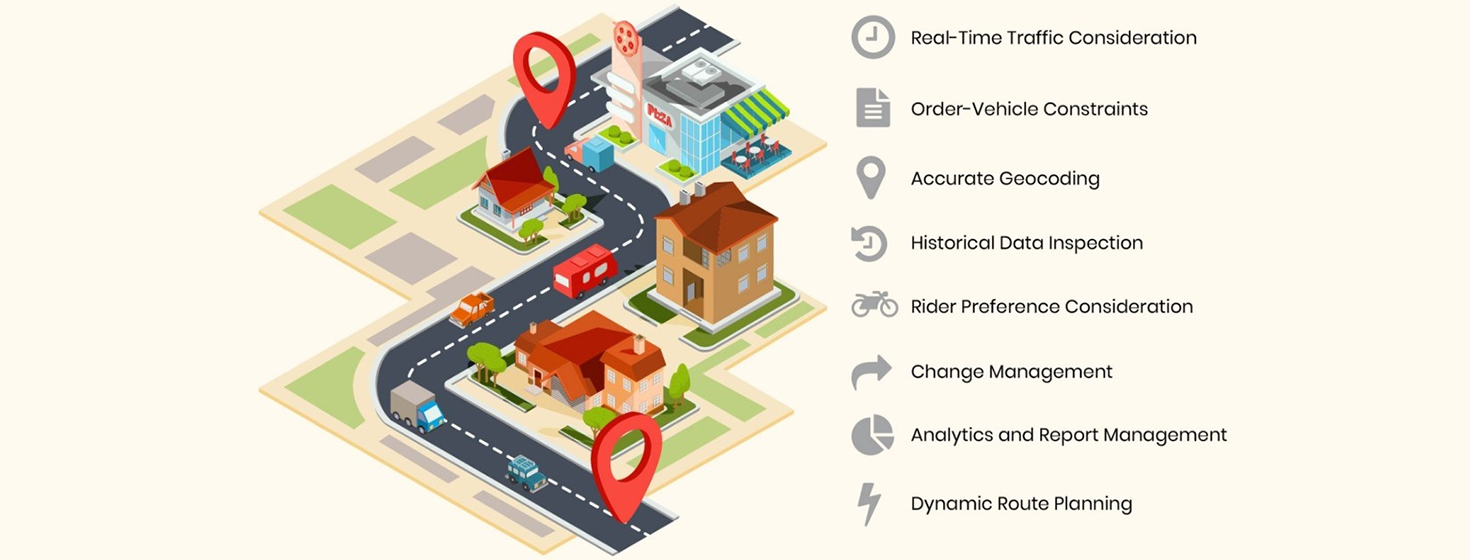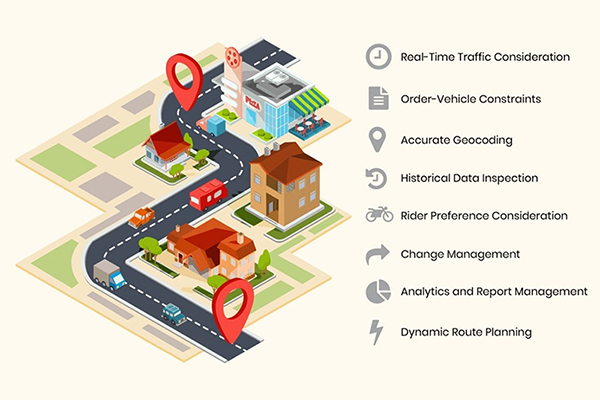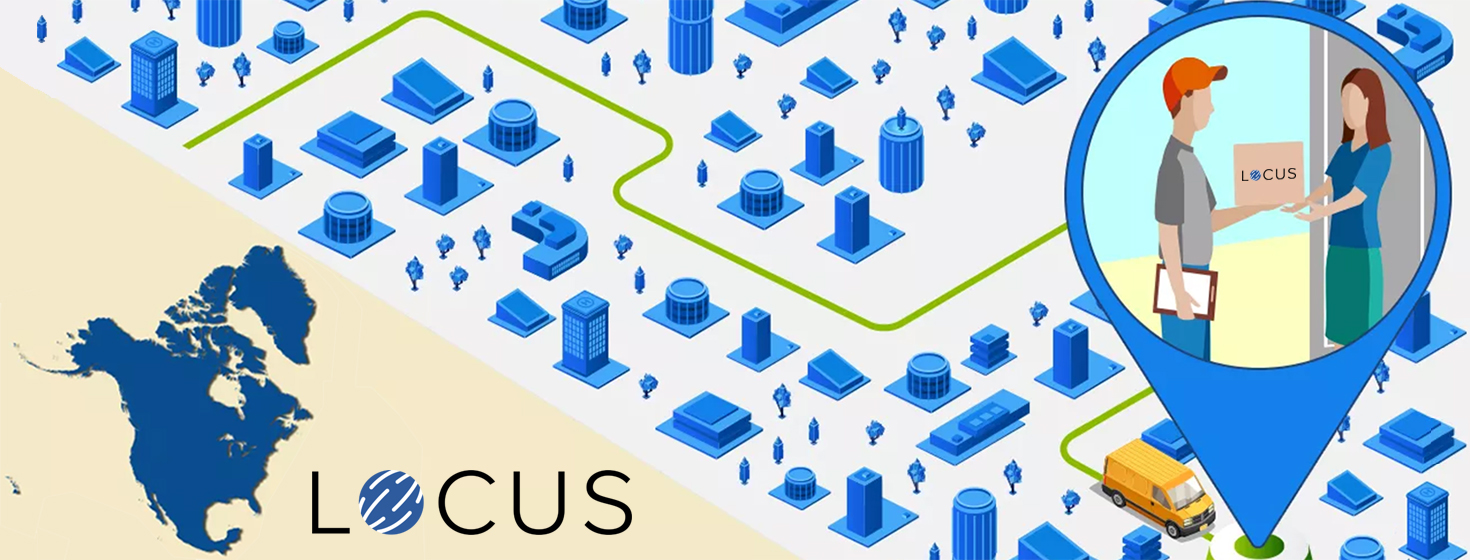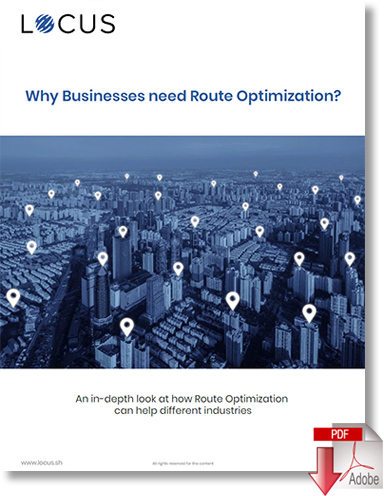8 Factors to Consider When Choosing Route Optimization Software for Your Logistics Business

With routing requirements of companies becoming more complex, it is of prime importance that companies choose the Route Optimization software according to save fuel costs, reduce overtime costs, and minimizing human dependency.
Route Optimization Software
Businesses often think of Route Optimization software as a guide for telling them the shortest distance between point A and B.
Even though Route Optimization software does provide that facility, modern-day software is a lot more than chaperones for guiding shipments from one location to another.
The advanced solutions in Route Optimization allow route planners to manage a fleet, get driving directions, add multiple stops, improve productivity and increase service-level agreement (SLA) adherence.
Route Optimization can thus lead to saving fuel costs, additional pick-up/delivery stops, reduction of labor overtime costs and minimizing human dependency.
With Route Optimization becoming the need of the hour for virtually every business operation, it becomes imperative that organizations choose their Route Optimization software with utmost care.
Here are the factors to keep in mind for selecting the correct Route Optimization software for your business:
Real-Time Traffic Consideration: A study says that in 2017, the U.S. alone incurred a congestion cost of $305 billion. Considering real-time traffic can not only save your logistic costs but can also ensure on-time delivery and better adherence to SLAs for increasing customer delight. Businesses should look for software that plans routes and calculates ETA based on dynamic, real-time data.
Order-Vehicle Constraints: Many a time software tend to focus on cold, hard data and ignore real life order-vehicle constraints. Often, two different genres of products, ex- electronics and perishable can’t be shipped together, at other times, a specific kind of product, say medicines can only be supplied in special vehicles. Softwares that consider these order-vehicle constraints have a better chance of helping businesses in real-world scenarios.
Accurate Geocoding: Virtually every Route Optimization software available in the market boasts of a geocoder. However, converting addresses into a particular point on the map to precise latitude and longitude coordinates is a task easier said than done. Understanding ambiguous addresses and comprehending local contexts is the key to accurate geocoding. Having a stellar database of local addresses and apartment locations is also a big plus.
Historical Data Inspection: Your Route Optimization software should examine historical data on three levels- Riders, Customers and Time of the day. A rider’s historical evidence can tell you about his skills, expertise, preferred time of deliveries and preferred region to work. On the other hand, a customer’s historical data can tell you about his preferred time slots, availability and any special instructions for delivery. Historical information of a given time of the day can give you insights about the prevailing traffic conditions of a region and working/closing hours of a particular building. Your Route Optimization software should learn from past experiences and plan routes accordingly.
Rider Preference Consideration: One of the biggest challenges in the implementation of routing plans is the resistance from the on-ground operations team. These teams are used to work in a particular manner and to change their entire operating system is a massive transformation for them. To smoothen out this process, it is important that your software takes preferences from the on-ground team to phase out the traditional system rather than trying changing the entire procedure on a single go.
Change Management: In case your on-ground team is still adamant on their traditional ways, it would make sense for your software provider to assign you a group of on-field experts who convince your on-ground resources and make the transition smoother. Training modules, incentives and success stories from other organizations can help motivate your on-ground staff to get used to your Route Optimization software.
Analytics and Report Management: Your Route Optimization software should give you the ability to track and manage your entire operations in real-time on a single platform. It should allow you to track the actual routes vs the planned routes and should help you compare the performances of your different business hubs. Your Route Optimization software should also provide you with a unified dashboard that allows you to track your operations in real-time.
Dynamic Route Planning: Your software should have the capability of optimally handling on-demand orders along with scheduled orders. Rerouting on the go is another feature that is increasingly preferred by businesses. In case the orders/preferences of the customers change while the rider is out to deliver, your Route Optimization software should be able to change and create new routes for the rider.
With routing requirements of companies becoming complex, it is of prime importance that companies choose the Route Optimization software according to their needs.
Software that plans routes intelligently to improve delivery efficiency and reduce costs will edge over others in the future.
How Locus Can Solve Your Routing Issues
Locus’ Route Optimization engine – ‘Locus Dispatcher’ provides businesses with an intelligent route planning suite that generates optimal & profitable delivery routes along with efficient resource utilization plan by using geocoding instead of pin codes.
With Artificial intelligence and Machine Learning coming to the fore, Route Optimization Softwares can help your logistics in every mile of delivery and Locus can be your partner in this journey of intelligent routes.
Infographic: Why Your Business Needs Route Optimization?
Related Article: How to Tackle Last-Mile Delivery Challenges Using Technology
How Route Optimization Can Help Improve Last-Mile Deliveries and Reduce Logistics Costs
Locus’ Dispatcher (route optimization), provides AI-based automated route planning that considers multiple real-life constraints and distribution models and provides the following features;
- Geocoding and accurate address detection IP to automate sorting processes (primary & secondary).
- Optimal fleet mix and route plan for the vehicles respecting business as well as local constraints such as traffic, possible route restrictions, etc.
- Intelligent clubbing of orders based on properties such as preferred delivery time slots, priority orders, location preference, and order specifications (weight, size, content, etc.).
- Control tower application to manage operational exceptions and predictive alerts on delays, vehicle breakdowns, idle time, etc to improve both customer experience and efficiency of delivery executives.
- Reducing turnaround time for the customer by optimizing first-mile operations, locations of warehouses/distributer centers, reducing sorting times at fulfillment centers and last-mile distribution centers.
- Predicting time windows of delivery for customers thereby increasing first attempt rates and higher customer experience.
- Electronic proof of delivery (EPOD) for reducing friction with customers and digitization of the processes.
- Fitting more deliveries in a day by minimizing driving hours with more efficient routes.
With Locus’ proprietary Geocoding and Vehicle allocation engine, Dispatcher provides transparency, efficiency, and consistency in your supply chain along with reducing logistics costs.
Article Topics
Locus News & Resources
How Can White Glove Service Increase Customer Loyalty? Building Your Business Around a Hyperlocal On-Demand Delivery Model AI-Backed Route Planning Solutions for Ecommerce Players U.S. and Canada Border will Temporarily Close amid Coronavirus Outbreak Multi-Echelon Supply Chain Inventory Optimization Slot Management: Customer-Preferred Delivery Time Windows Last Mile Delivery Route Optimization and the Changing Logistics of Grocery Stores More LocusLatest in Transportation
Baltimore Bridge Collapse: Impact on Freight Navigating Amazon Logistics’ Growth Shakes Up Shipping Industry in 2023 Nissan Channels Tesla With Its Latest Manufacturing Process Why are Diesel Prices Climbing Back Over $4 a Gallon? Luxury Car Brands in Limbo After Chinese Company Violates Labor Laws The Three Biggest Challenges Facing Shippers and Carriers in 2024 Supply Chain Stability Index: “Tremendous Improvement” in 2023 More Transportation















